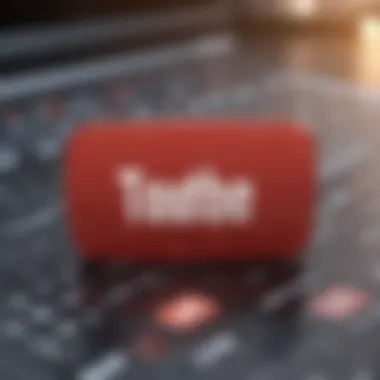Key Strategies to Profit from YouTube Content


Intro
Navigating the world of YouTube content creation isn’t just about passion or creativity. It's a landscape where strategic planning and insights can make a world of difference in generating revenue. Many newcomers step into this arena thinking that sheer talent or a unique concept will automatically lead to financial success. However, the truth is somewhat different. A systematic understanding of the platform’s intricacies can mean the difference between mere visibility and long-term profitability.
YouTube isn't just a video-sharing platform. It’s a multifaceted ecosystem that intertwines audience engagement, network building, and effective monetization. In this article, we’ll break down the components that can help you shift from just creating content to successfully yielding income from it. Whether you're a budding YouTuber or someone looking to resurrect a dormant channel, it’s essential to comprehend what's required.
Investment Dictionary
Before diving deeper into the strategies, it might be beneficial to clarify some terms and concepts that frequently arise in discussions about content monetization.
Key Terminology Breakdown
- Monetization: This refers to the process of turning your content into a source of income. This can be achieved through various methods like ads, sponsorships, and merchandise sales.
- CPM (Cost Per Mille): This metric indicates the cost advertisers pay per 1,000 ad impressions. Understanding CPM is essential for estimating potential earnings from ad revenue.
- Engagement Rate: A crucial measure reflecting how users interact with your content. Higher engagement typically translates to better visibility and, ultimately, monetization prospects.
Common Monetization Types Explained
- Ad Revenue: The most straightforward method, where creators earn money through advertisements displayed on their videos. This is generally handled through YouTube's Partner Program.
- Sponsorships: Companies may pay you to promote their products or services, leveraging your audience to boost their brand recognition.
- Merchandising: Selling branded items associated with your channel can create a direct line to income while fostering community.
- Memberships and Donations: Platforms like Patreon allow fans to support creators financially, thus providing a steady income stream.
"Content creators must think strategically about the kinds of monetization methods they choose to pursue, as each avenue can affect audience perception and engagement differently."
Having a solid grasp on these terms can create a strong foundation for understanding more complex strategies. As we move forward, we will weave these concepts into actionable plans and explore in detail how they interplay with effective content strategies.
Understanding YouTube as a Platform
YouTube is not just a place to watch cat videos or the latest music clips; it is a robust ecosystem where content creators can earn substantial income. Knowing how to navigate this platform is pivotal for anyone wanting to monetize their content effectively. This section aims to unpack the various aspects of YouTube, shedding light on its transformation and the contemporary trends that shape how users engage with content.
In understanding YouTube as a platform, it is crucial to recognize its multifaceted nature. It isn't merely a hosting service; it’s a social network, video-sharing platform, and marketing tool all rolled into one. Creators have the ability to reach millions, and likewise, they are exposed to countless challenges—competition, algorithm changes, and audience preferences. Grasping these elements allows creators to devise strategies that leverage YouTube's features for better monetization and audience engagement.
The Evolution of YouTube
YouTube's journey from a simple video-sharing site to a premier platform for content creation is remarkable. Launched in 2005, it quickly became a playground for consumers to express themselves and share videos. Early adopters found a way to tap into niche markets, leading to the rise of the first-generation YouTube stars.
By 2006, Google acquired YouTube, which distinctly shaped its trajectory. The integration of advanced algorithms meant users could discover personalized video recommendations. The introduction of monetization options in 2007 opened the floodgates, allowing creators to earn a slice of the advertising revenue. Over the years, the platform has diversified its features—live streaming, Super Chat for viewer donations, and memberships revolutionized how revenue can be generated aside from traditional ads.
In this ever-evolving landscape, the shift toward long-form content and the growing popularity of YouTube Shorts reflects changing viewer habits. Creators now have to stay nimble and adapt their approach to fit these trends while still keeping the foundational elements of creativity and authenticity.
Current Trends in Content Consumption
Content consumption on YouTube has become a finely tuned dance of preferences, habits, and technology. Understanding these trends is essential for any creator wanting to monetize effectively.
- Short-Form Video: The surge of short-form content, such as TikTok-style clips, has grabbed the attention of viewers with shorter attention spans. Creators can capitalize on this trend by producing engaging bite-sized videos that invite quick interactions.
- Live Streaming: This has exploded in popularity, offering real-time engagement opportunities. Audiences enjoy this format for the immediacy and the opportunity to interact directly with influencers and creators.
- Educational Content: There's been a notable rise in searches for how-to and educational videos. This trend opens up avenues for creators to monetize through sponsorships and targeted ads.
- Channels and Niches: Specialization is becoming a key strategy. Channels dedicated to specific genres or interests build strong communities, leading to higher engagement rates and loyalty.
Rather than adhering to a one-size-fits-all doctrine, content creators are faced with the necessity of being versatile and responsive to these currents. Staying attuned to viewer preferences makes it easier to tailor content that resonates, ultimately leading to better monetization strategies.
Essential Requirements for Success
In the bustling world of YouTube, it's not enough to just post content; understanding the essentials for success is paramount. This section brings to light what is crucial for anyone looking to monetize their efforts on this vast platform. The landscape is competitive, but being grounded in the right strategies can make all the difference. Whether you are stepping into the YouTube arena or refining your existing channel, these requirements form the bedrock of your potential profitability.
Niche Selection
Choosing the right niche is a linchpin in your YouTube journey. It's how you carve out your space amidst the clutter. A carefully selected niche allows you to stand out and attract a targeted audience. For instance, if you have a passion for fishing, diving deeply into specific techniques or unique local spots can connect you to viewers who share that interest.
Additionally, a viable niche should not only align with your passion but also possess potential revenue streams. Think about trends, market demand, and your expertise. Content creators need to analyze the competition. If you see an oversaturated market, it may be wise to tweak your focus.
In practical terms:
- Think like a consumer: What excites you? What dilemmas do you face that no one else seems to address?
- Research trends: Websites like Reddit and Google Trends can help you gauge what's popular right now.
- Experiment: Don’t be afraid to pivot if something isn't working for you.
Understanding Your Target Audience
Once you have those niche goggles on, it’s time to focus on who’s watching your content. Understanding your target audience is like having a map in uncharted territory. It informs everything from your video style to your promotion strategies.
You need to ask yourself important questions:
- Who are they? Consider age, gender, cultural background, and interests.
- What do they want? Do they seek entertainment, information, or a community?
To gather insights, analytics tools are your best friends. Dive into YouTube Analytics to learn details about your viewers' demographics and watch habits. You can also engage in surveys or polls on social media to get direct feedback.
In sum, knowing your audience helps you craft content that is relevant and engaging. The better you understand them, the more likely they are to keep returning for more.
A content creator who resonates with their audience can see increased loyalty, which is often worth more than views.
Having a strong grasp of and meeting the needs of your audience will not only foster a sense of community but also position you as a trusted source in your niche. Positively engaging your viewers could lead to better referral traffic, enhancing your visibility on the platform.


Crafting Engaging Content
Crafting engaging content is the heart and soul of any successful YouTube channel. In today's fast-paced digital climate, where attention spans are shorter than a hummingbird's flight, it's crucial to capture interest quickly. The content you create doesn't merely exist to fill the void; it must resonate with viewers, giving them a reason to click, stay, and share. This section outlines the key elements that can elevate your content from ordinary to unforgettable, and how this impacts your monetization strategies.
Quality vs. Quantity
When it comes to YouTube, there’s an ongoing debate about whether quality or quantity reigns supreme. It’s easy to be tempted by the idea of flooding the platform with videos in hopes of catching a few views here and there. However, this approach is often shortsighted. Quality definitely takes the cake.
Viewers are after content that is informative, entertaining, or both. A high-quality video captures attention and encourages likes, shares, and subscriptions. Think of it this way: one well-produced video can attract more viewers than ten hastily thrown-together clips. This is not to say quantity is irrelevant; regular uploads help keep your channel active, but they should not compromise the integrity of the content. Here are a few thoughts to consider:
- Value over Volume: Prioritize content that offers real value, whether it be through education, entertainment, or expression.
- Consistency: Find a balance that allows for continuity but safeguards quality. Whether that’s once a week or bi-weekly, stick to a schedule that keeps your audience engaged without sacrificing your standards.
- Engagement Metrics: Focus on viewer feedback. Higher watch time, lower drop-off rates, and more interaction are typically signs of quality content that resonates.
Storytelling Techniques
Every video you produce has a tale to tell. Storytelling is a powerful method to create an emotional connection with your audience. The most effective content is often rooted in narratives that viewers can relate to or learn from. This doesn’t mean every video has to follow a dramatic arc, but leveraging a storytelling approach enhances engagement.
Consider the following tactics when crafting your story:
- Hook Your Audience: Begin with a captivating hook that draws viewers in. This could be a compelling question, a startling statistic, or even an engaging personal anecdote.
- Structure Matters: Employ a clear structure, having a beginning, middle, and end. This gives your audience a sense of direction.
- Relatability is Key: Make your stories applicable to your audience’s life. Shared experiences or insights can create a sense of community and connection.
"The most effective content is often rooted in narratives that viewers can relate to or learn from".
Visual and Audio Production Standards
The visual and audio elements of your content should not be an afterthought; they are critical in establishing your brand and keeping viewers engaged. Poor production quality can quickly turn off an audience, regardless of how strong the content might be. Therefore, it’s essential to pay attention to these aspects:
- Consistent Branding: Maintain a consistent visual style across all your videos. This includes color palettes, graphics, and fonts that are representative of your brand identity.
- Clarity in Visuals: Invest in a good camera and lighting equipment. Clear, high-quality visuals can make a world of difference.
- Audio Matters: Often overlooked, audio quality can make or break a video. Consider investing in a decent microphone—good sound enhances viewer experience and keeps them returning.
By focusing on crafting high-quality, engaging content through a balance of quantity and storytelling, while maintaining high production standards, you set the stage for monetization and long-term success on YouTube.
Monetization Strategies
Monetizing content on YouTube is not just about slapping on some ads and calling it a day. It's a multifaceted approach that entails understanding the intricacies of the platform and exploring various revenue avenues. Creators must be strategic about how they generate income, ensuring they can cultivate a sustainable and lucrative channel.
By delving into monetization strategies, content creators can discover the pathways that best suit their style and audience. This journey involves evaluating both short-term gains and long-term sustainability. Here are key components that define successful monetization:
- Diversifying Income Sources: Relying solely on ad revenue can be like having all your eggs in one basket, which can be risky. By branching into different streams, you protect yourself against unforeseen changes in the platform's policies or ad rates.
- Building a Strong Brand: Brand loyalty plays a significant role in monetization. When audiences resonate with you, they're more likely to support your ventures beyond just watching your videos.
- Tracking Trends: Staying ahead of trends helps in timely content creation, ensuring you’re relevant and can capitalize quickly on emerging interests.
"The key to YouTube success is not only about creating great~content, but also mastering the business side to ensure it pays off."
With this foundation in mind, here’s an in-depth look into the various monetization strategies that can yield results for aspiring creators.
Ad Revenue Generation
Ad revenue remains one of the primary revenue streams for many YouTubers. However, it’s essential to grasp how this system operates. Creators earn money through advertisements that are run on their videos, but the amount they make can vary significantly based on factors like:
- Audience Demographics: Advertisers pay differently based on who is viewing. For instance, ads viewed by affluent demographics may fetch higher rates.
- Engagement Metrics: Higher views and interaction rates can attract better ad deals.
- Content Category: Content in niches like finance and technology often has higher ad rates than, let’s say, lifestyle vlogs.
To optimize ad revenue, creators need to produce content that engages viewers long enough to exceed threshold watch times. Keep an eye on your analytics and experiment with video lengths to hit that sweet spot.
Sponsorships and Brand Collaborations
Sponsorships can double as a golden ticket. Brands often look to partner with YouTubers to reach specific audiences. The benefits of these collaborations are multifold:
- Higher Earnings: Direct deals with brands often yield more than ad revenue alone.
- Enhanced Credibility: Partnering with respected brands can elevate your status in the community.
- Audience Engagement: Tailored promotions can resonate more with viewers when they feel genuine.
Establishing a solid media kit showcasing viewership stats, audience demographics, and engagement levels can make the approach easier when reaching out to potential sponsors. Don't forget to negotiate terms and create content that feels authentic rather than forced.
Affiliate Marketing Opportunities
Affiliate marketing offers a unique way for YouTube creators to turn their audience into a revenue-generating machine. In this model, creators promote products or services and earn a commission based on sales generated through their unique links. Consider the following:
- Product Relevance: Promote items that align with your content and your audience's interests to boost conversion rates.
- Transparency: Always disclose affiliate relationships. Trust goes a long way with viewers.
- Engagement with Products: Highlight products in an authentic manner—show how they fit into your daily life or how they enhance your content's theme.
Including affiliate links in video descriptions or promotional segments can seamlessly integrate this approach into your content without feeling too salesy.
Merchandising and Product Sales
Merchandising is another dynamic way to monetize content. Creating and selling products—from T-shirts to digital products—can foster a tangible connection with your audience. Here are some considerations:
- Brand Alignment: Ensure that any merchandise reflects your brand identity and resonates with your audience.
- Quality Over Quantity: Focus on producing high-quality items that will stand the test of time—instead of mass-producing low-quality goods.
- Online Sales Platforms: Utilize print-on-demand services or platforms like Teespring or Redbubble to simplify logistics.
Set up channels that make purchasing easy and effortless, turning casual viewers into loyal customers supporting your brand.
Building a Community and Engagement


Creating a successful YouTube channel isn't just about making videos; it's also about building a community around your brand. An engaged audience can be a game changer when it comes to monetizing your content. When viewers feel a sense of belonging and loyalty, they're more likely to engage with your content, come back for more, and even support you financially through various channels. Thus, fostering a community isn’t merely an option; it’s a crucial strategy for long-term success.
Fostering Viewer Interaction
Engagement begins with how you interact with your viewers. Responding to comments, hosting Q&A sessions, or initiating discussions in your videos can significantly enhance viewer interaction. When you take the time to acknowledge your audience, you send a message that their opinions matter. This can create an environment where viewers feel motivated to share, comment, and even promote your videos within their networks.
Additionally, consider incorporating interactive elements such as polls or challenges. You could run weekly challenges where viewers are tasked with creating their content based on your prompts, which not only fosters engagement but also promotes a creative culture within your community.
An engaged community is not just about numbers; it's about real connections that foster loyalty and support.
Here are a few ways to keep the interaction lively:
- Use Calls to Action: Encourage viewers to comment by asking questions or for their opinions on your videos.
- Live Streams: Go live periodically to chat with your audience in real time, making the interaction more personal.
- Giveaways: Organizing contests or giveaways can provide a fun way to entice interaction and reward your loyal viewers.
Utilizing Social Media for Engagement
While YouTube is your primary platform, it's essential to harness the power of social media to expand your reach. By creating profiles on platforms like Facebook, Instagram, or Reddit, you can promote your content beyond YouTube and spark more in-depth conversations.
Social media also lets you share snippets or behind-the-scenes content, giving your audience a peek into your creative process. This can lead to higher viewer investment and can even drive traffic back to your YouTube channel. Here are some strategies you might want to consider:
- Share Your Videos: Don't wait for viewers to find your content; proactively promote it across all your social channels.
- Engagement Posts: Create posts that prompt discussion. Ask for opinions, share memes related to your niche, or post intriguing questions that lead to discussions.
- Cross-Promotion with Other Creators: Collaborating with other creators can expose new audiences to your content. This kind of partnership can help foster inter-community engagement, benefiting all parties involved.
Building a community and facilitating engagement takes effort, but it lays a strong foundation for potential monetization. The more invested your audience feels, the more likely they are to support your growth, both as viewers and in other financial means.
Analytics and Performance Evaluation
Analyzing performance metrics is absolutely vital for any content creator. It’s like having a compass; it guides you through the sometimes murky waters of YouTube monetization. Without this understanding, you risk sailing in circles, stuck in a whirlpool of uncertainty.
When it comes to YouTube analytics, there's more than meets the eye. It goes beyond just seeing how many views your latest video racked up. It involves digging deeper into the feedback loop between you and your audience. These metrics can help you tweak your content strategy, align your offerings with audience preferences, and ultimately pave the way for financial success.
Understanding YouTube Analytics
YouTube Analytics serves as a treasure map, showcasing not just how well your videos perform, but also revealing insights about the viewers consuming your content. Every view, every like, and each comment contributes to a pool of data that paints a broader picture of your channel's performance.
Key components of YouTube Analytics include:
- Watch Time: This gauges how much time viewers spend watching your videos. It’s a clear indicator of whether your content hook is doing its job.
- Audience Retention: This helps you discover at which point viewers lose interest. Knowing this can radically enhance your future content.
- Traffic Sources: Unpacking where your views come from will show you whether your titles, thumbnails, and descriptions are indeed working; not all roads lead to Rome, after all.
- Demographics: Grasping who watches your channel allows you to tailor content specifically for your target audience.
By regularly reviewing these analytics, you can adapt your approach. Remember, the key isn't to chase the numbers blindly, but to understand the story they tell.
Key Metrics for Success
Identifying the right metrics can be a game changer. Think of them as the scorecard of your efforts in the realm of YouTube. Each metric tells a different tale about your content’s performance and your audience's engagement. Here’s a breakdown of essential metrics to keep in mind:
- Subscriber Growth: Monitoring how many new subscribers you gain during or after specific videos helps identify what resonates with viewers.
- Engagement Rate: Tracking comments, shares, and likes helps paint a picture of how invested viewers are with your content.
- Click-Through Rate (CTR): This metric reveals how often viewers click on your video after seeing the thumbnail and title, giving insight into your video’s appeal.
- Revenue Reports: Regular checks on how much ad revenue or earnings from sponsorships you are bringing in can guide future decisions.
- Return Viewers: Understanding how many viewers come back after their first interaction can indicate loyalty and interest in your content.
Focusing on these metrics allows creators to pivot their strategy as needed. Ignoring them? That could be tantamount to shooting in the dark. Ultimately, a robust analytics regimen not only enhances content quality but also offers a roadmap to sustained growth and revenue generation.
"What gets measured gets managed."
The blend of analytics can bring clarity to your journey. Crafting and adjusting content based on solid data is just as important as being creative. The numbers will guide you to cultivate a profitable channel on YouTube.
Navigating YouTube's Algorithm
Understanding YouTube's algorithm is akin to getting the lay of the land before venturing into the wilderness. The algorithm is, at its core, a complex system that determines what content is shown to users based on their preferences and behaviors. In the context of monetizing content, grasping how this algorithm operates is not just advantageous; it’s imperative. By mastering its intricacies, content creators can improve their visibility and, consequently, their earning potential.
Factors Influencing Visibility
When it comes to visibility, several factors intertwine to establish a video's fate on the platform. Here’s a quick rundown:
- Watch Time: This is the duration viewers spend watching a video. The more watch time a video garners, the more favorable its ranking. Think of it as a popularity contest; videos that keep audiences engaged will rise to the top.
- Engagement Metrics: Likes, comments, and shares are all part of the engagement puzzle. The more engagement your video sees, the better its chances of being featured in recommended videos. High levels of interaction tell the algorithm that your content is valuable and worth promoting.
- Click-Through Rate (CTR): This percentage reflects how often viewers click on your video when it's displayed in search results or recommendations. A compelling thumbnail and title can boost your CTR significantly. After all, it’s the first impression that counts.
- Consistency in Posting: Regular uploads signal to the algorithm that you are an active creator. This is important because consistent engagement can lead to a loyal audience base, which in turn continues to drive viewership.
Navigating these factors requires a combination of creativity and strategy. It’s not only about churning out content, but about crafting it in a way that resonates with viewers.
"Understanding YouTube's algorithm is like learning the rules of a game; without this knowledge, you’re setting yourself up for frequent setbacks."
Optimizing Videos for Search
To maximize the potential for viewer discovery, optimizing videos for search becomes vital. Here are actionable strategies to do just that:
- Use Descriptive and Relevant Titles: Titles should be both engaging and descriptive. Incorporating relevant keywords helps the algorithm understand what your content is about.
- Craft Detailed Descriptions: The video's description is a treasure trove of information. Include keywords that represent your content and offer a concise summary. Descriptions allow the algorithm to match your video with user searches effectively.
- Tagging Your Videos: Tags serve as additional metadata that help categorize your content. Use a blend of specific and broad tags to broaden your reach. Choosing the right tags can positively influence the algorithm's perception of your video.
- Thumbnail Optimization: Though they don’t directly influence SEO, attractive thumbnails can increase your CTR. Create visually appealing graphics that summarize the video content and provoke curiosity.
- Utilize Playlists: Grouping related videos into playlists can keep viewers on your channel longer. Playlists not only enhance view time but also improve the way your content gets indexed in search results.
By embedding these practices into your content strategy, you position yourself favorably within YouTube's search algorithm. Don’t forget: constant adaptation is key. As trends change and viewership behaviors shift, staying proactive can keep your channel afloat in the ever-competitive waters of YouTube.


Legal and Ethical Considerations
When stepping into the bustling arena of YouTube, creators must tread carefully around the legal and ethical mazes that govern the platform. Ignoring these considerations could lead to costly mistakes or even damage one's reputation. As invaluable as the potential for income can be, respecting the boundaries established by copyright, fair use, and YouTube's terms of service is crucial for sustainable success.
Copyright and Fair Use
Copyright is like a legal shield for creators. It grants them control over their original work, protecting their rights to distribute and monetize it. YouTube's ecosystem thrives largely on content that speaks from the heart, be it a tutorial, a vlog, or a music cover. However, creators sometimes unwittingly step on the toes of copyright law by using unlicensed materials or even snippets from other creators’ videos. This not only risks their content being taken down but can also lead to strikes against their accounts, which may hinder monetization efforts.
YouTube operates a Content ID system that scans uploads for copyrighted music and videos. If it detects any infringement, it flags the content—often serving as a harsh reminder that respect for others' creative works is mandatory.
- To navigate this minefield, here are some tips:
- Always seek permission when using someone else’s work.
- Use royalty-free music or content from sites like Creative Commons.
- Familiarize yourself with clauses surrounding fair use, which might allow for limited usage under specific conditions, such as commentary, criticism, or educational purposes.
Understanding these concepts is not just about avoiding penalties. It also establishes a culture of respect and trust within the creative community. Honor among creators boosts collaboration opportunities, enriching the platform for everyone.
"Understanding copyright not only protects your work but also cultivates creativity on the platform. Respect the rights of others, and in return, expect respect for your content."
Terms of Service Compliance
Every platform has its rule book, and YouTube is no exception. The Terms of Service outline what is permissible on the platform. Ignoring these can have severe repercussions, including account termination. Content creators often overlook these essential guidelines in their fervor to create and monetize.
YouTube expects creators to maintain transparency, avoid misleading information, and respect the rights of others. For example, using deceptive practices to boost views or engagement may result in penalties. Furthermore, promotional content needs to be labeled correctly. A failure to disclose sponsorships or advertisements can lead to violations that not only impact a creator’s standing with YouTube but may also attract scrutiny from regulatory bodies.
Here's why adhering to the Terms of Service is paramount:
- It protects creators legally and ethically, ensuring they are operating within a safe framework.
- It enhances a creator's reliability in the eyes of their audience and sponsors.
- Compliance helps in building a lasting community where trust is fostered.
Understanding and following legal and ethical guidelines is not an option, but a necessity for anyone serious about lasting success on YouTube. By prioritizing these elements, creators can not only secure their passions but also pave the way for a more sustainable pathway towards monetization.
Sustaining Long-Term Growth
In the world of YouTube, sustaining long-term growth isn't just a lofty goal; it's an essential strategy for monetization. Understanding how to keep your audience engaged over time can significantly affect your financial returns and overall success on the platform. Unfortunately, many creators see spikes in views and subscribers only to find their growth stalling, leading to frustration and dwindling potential earnings.
To ensure that your YouTube channel remains vibrant and relevant, it is vital to delve into several elements:
- Audience Adaptation: Viewer preferences and market trends are like quicksand, constantly shifting. Regularly assessing what your audience finds valuable or entertaining can guide your content creation processes. If you fail to keep an ear to the ground, you might find your channel becoming stale.
- Quality Content: While flooding the channel with videos can seem tempting, the focus should ultimately be on quality. As every seasoned creator knows, appealing and valuable content retains viewers. People come for entertainment but remain for substance. Think back to content that resonated with you—there's usually a unique touch or authenticity that makes it stand out.
- Engagement Initiatives: Creators who continuously foster engagement will often witness improved audience loyalty. Polls, Q&A sessions, or even asking viewers to suggest topics can help create a community-driven atmosphere. This feedback loop not only keeps content fresh but can also spearhead your creativity in unexpected ways.
Adapting to Market Changes
Adapting to market changes is akin to being a weather vane—always ready to catch the wind from the latest trends. The YouTube landscape is dynamic, influenced by algorithm changes, new technologies, and shifts in community interest across the globe. Here are some critical aspects to consider:
- Monitoring Trends: Stay informed about trends both within and outside your niche. Using tools like Google Trends or YouTube's own trending page helps identify what’s capturing viewers' attention. By understanding these movements, you can pivot content without losing your core identity.
- Flexible Content Strategy: If something feels off in your analytics, re-evaluate and potentially revise your content strategy. Is there a new genre or style gaining traction? Being willing to experiment with your formula can reinvigorate your channel.
"The key to staying relevant is not just to follow trends, but to understand which ones align with your brand's values and mission."
Continual Learning and Networking
The journey of a content creator should never be stagnant. Continual learning and networking fuel the engine of a successful YouTube career. This often means broadening your horizons in various ways:
- Educational Resources: Utilize online courses, webinars, or workshops focused on content creation and digital marketing. Platforms like Coursera or Udemy offer valuable insights into aspects like SEO, video editing, and audience engagement strategies. Keeping yourself updated likewise allows you to elevate the quality of your content iteratively.
- Join Creator Communities: Network with fellow creators through forums or social media groups. These connections can be repurposed for brainstorming, sharing best practices, or simply offering support when the going gets tough. Websites like Reddit and Facebook have active communities where creators discuss challenges and successes.
- Collaboration Opportunities: Collaborating with other YouTubers can also be an excellent avenue for mutual growth. Shared audiences can enhance visibility and introduce your channel to individuals who may appreciate what you bring to the table.
In sum, the road to sustained growth in YouTube is marked by adaptability, continuous learning, and community engagement. By strategically implementing these principles, creators not only pave the way for financial success but also cultivate an enriching environment for their audience.
Epilogue: Assessing Your Feasibility
Stepping back and evaluating your readiness to monetize content on YouTube is crucial. This stage often separates the ambitious from the successful. Here, you not only need to assess what you aim to achieve but also whether you possess the tools, knowledge, and perseverance necessary for the journey ahead.
Evaluating Personal Goals and Resources
Understanding your personal goals is like having a compass on a road trip. What drives you? Is it the thrill of sharing your knowledge, the allure of financial independence, or perhaps a blend of both? A clear understanding of your motivations will guide your content creation and help you stay grounded when challenges arise.
Alongside your ambitions, you must inventory your resources—both tangible and intangible. This means asking yourself:
- What skills do I bring to the table? Are you a whiz with editing video or have a knack for storytelling?
- Do I have the necessary equipment? High-quality cameras or smartphones, good microphones, and editing software.
- How much time can I realistically dedicate to my channel? You’ll need to consistently create and publish content, so being honest about your available time can save you some headaches down the line.
Recognizing these elements can help set realistic expectations and prepare you for the rollercoaster ride ahead. As they say, "Failing to plan is planning to fail."
Taking the Next Steps
Once you have a grasp on your personal motivations and resources, the next move is crucial. Consider laying out a roadmap. Begin by outlining specific milestones you wish to achieve. For instance, is your immediate goal to reach a certain number of subscribers or to earn your first dollar through ad revenue? Breaking your grand mission into smaller, manageable steps makes the process less overwhelming.
Moreover, don’t shy away from seeking feedback. Engaging with potential viewers or fellow content creators, even if just virtually, can provide invaluable insights. Platforms like Reddit offer communities centered around YouTube where you can learn and share experiences.
Remember, persistence and adaptability are your friends. You might face setbacks, like an unexpected drop in viewership or changes in YouTube's algorithm that don't favor your content style. But staying flexible and responsive to these changes is essential. Keep in mind:
- Continuously learn by watching tutorials or reading current articles on trends.
- Engage with your audience consistently to build rapport and loyalty.
- Consider collaboration with other creators, which can open new doors and increase exposure.
Ultimately, assessing your feasibility is about aligning your dreams with practical actions. Balancing ambition with realism can offer a clearer, more focused path to success on YouTube.







